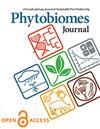Deep-rooted plant species recruit distinct bacterial communities in subsoil than in topsoil
IF 2.6
3区 生物学
Q2 MICROBIOLOGY
引用次数: 0
Abstract
Deep-rooted plants can obtain water and nutrients from the subsoil, making them resilient to climatic changes. Plant growth and health may depend on interactions with root-associated bacteria, but the composition and assembly dynamics of deep root-associated bacterial communities are unknown, as are their ability to supply plants with nitrogen (N). Here, we investigated the root-associated communities of the three deep-rooted perennial crops, lucerne (Medicago sativa), intermediate wheatgrass (Thinopyrum intermedium), and rosinweed (Silphium integrifolium), grown in 4 m tall RootTowers, under semi-natural conditions. Across the plant species, higher bacterial abundance and lower diversity were found in the root-associated communities compared to the bulk soil communities. The deep root-associated communities were enriched in the genera Pseudarthrobacter, Pseudomonas, Rhizobium and Streptomyces, genera found to harbor a wide variety of bacterial species expressing plant beneficial traits. The composition of the deep root-associated bacterial communities were plant species specific, and clearly distinct from the shallow communities. Additionally, the deep root-associated communities comprised primarily amplicon sequence variants (ASVs) that were omnipresent in the bulk soil, and to a limited extent ASVs that could have been transported from the topsoil or potentially from the seed. Abundances of genes involved in N-cycling: amoA, nifH, nirK, nirS and nosZ showed plant species specific patterns, and indicated that intermediate wheatgrass and lucerne recruit N-fixing bacteria even at 3 m depth for N supply. This work provides the first steps toward understanding plant-microbe interactions of deep-rooted crops, which are important for evaluating these crops for use in future sustainable cropping systems.深根植物在底土中比在表土中吸收不同的细菌群落
深根植物可以从底土中获得水分和营养,使其能够适应气候变化。植物的生长和健康可能取决于与根系相关细菌的相互作用,但深层根系相关细菌群落的组成和组装动力学以及它们向植物提供氮(N)的能力尚不清楚。在这里,我们调查了在半自然条件下生长在4米高的RootTowers中的三种根深蒂固的多年生作物,苜蓿(Medicago sativa)、中间麦草(Thinopyrum intermediaum)和罗汉子(Silphium integrifolium)的根系相关群落。在整个植物物种中,与大块土壤群落相比,根系相关群落的细菌丰度更高,多样性更低。深根相关群落在Pseudarthrobacter属、Pseudomonas属、Rhizobium属和链霉菌属中富集,这些属携带多种表达植物有益性状的细菌。深根相关细菌群落的组成是植物物种特有的,与浅根群落明显不同。此外,深根相关群落主要包括扩增子序列变体(ASV),它们普遍存在于大块土壤中,并且在有限的程度上,ASV可能是从表层土或种子中运输的。大量参与氮循环的基因:amoA、nifH、nirK、nirS和nosZ显示出植物物种特异性模式,并表明中间麦草和苜蓿即使在3米深的地方也能吸收固氮细菌来提供氮。这项工作为了解根深蒂固的作物的植物-微生物相互作用提供了第一步,这对评估这些作物在未来可持续种植系统中的使用非常重要。
本文章由计算机程序翻译,如有差异,请以英文原文为准。
求助全文
约1分钟内获得全文
求助全文

 求助内容:
求助内容: 应助结果提醒方式:
应助结果提醒方式:


